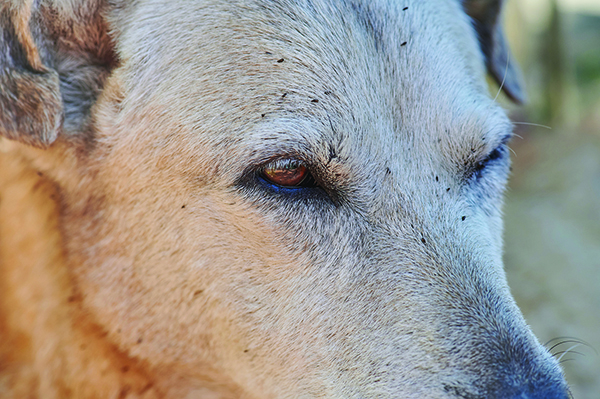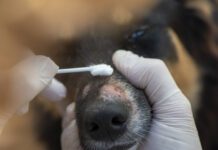
Nobody thinks fleas are good for dogs. But do you know why they are bad? And that they are bad for you and your family, too?
Fleas have been around for centuries. They carry organisms that cause disease in both animals and humans. They were the vector for the bubonic plague that killed millions of people back in the Middle Ages. Flea-borne diseases you’re more likely to see in this day and age include parasitic larvae that infect the skin and eyes; rickettsial bacteria that cause fever and systemic illness; and Bartonella, the bacteria that causes cat scratch fever.
Fleas also carry tapeworms (Dipylidium caninum). If your dog swallows a flea while chewing at his flea bites, he can end up with tapeworms in his intestines. Owners usually become aware that their dog has tapeworms when they see rice-like segments in the hair around the dog’s anus or in the dog’s feces. These segments are actually just tiny pieces of very large, long worms. Yuck.
Fleas suck a lot of blood. They can consume enough to cause a life-threatening anemia, especially in young puppies of any breed and in toy-breed adult dogs. This preventable situation requires intensive veterinary intervention, including blood transfusion, if the dog is to survive.
As if that weren’t enough, fleas cause considerable discomfort for your dog. Flea saliva contains histamine-like compounds and other irritating substances that result in inflammation and itchiness around the bites. If your dog happens to be allergic to fleas, this inflammation and itch is amplified exponentially. One flea bite can make a flea-allergic dog’s entire body break out!
BREAK THE FLEA LIFE CYCLE
In order to effectively prevent fleas or treat a current flea problem, it is important to understand the life cycle and habits of the flea.
The adult fleas you see on your dog are not the biggest issue. They make up less than 5% of the problem. The more important 95% lives in your home environment in the form of adult fleas and pre-adult flea stages (eggs, larvae, and pupae). Each adult flea only lives a few weeks.
So, in and of itself, one flea may not seem like a big deal. The problem is, a female flea lays approximately 50 eggs a day – that’s 50 eggs a day, for 20 days, or about 1,000 eggs laid before that one flea dies.
It takes at least three weeks for each egg to go through three molts and become an adult. Let’s say half are female. So now we have 500 fleas, laying 50 eggs a day, for 20 days, which equals 500,000 flea eggs laid in your home, within six weeks of one flea entering the premises. The female half of these 500,000 fleas will lay 50 eggs a day, and before you know it, you are up to 12.5 million flea eggs in your home.
ENVIRONMENTAL SOLUTIONS FOR FLEAS
So, if you have an active flea problem, it is important to include this environmental population in your treatment plan. An integrated flea-control program includes killing adult fleas, both on the dog and in the environment, as well as eliminating and preventing pre-adult flea stages from the environment.
For eliminating existing fleas and pre-adult fleas from your home, heavy vacuuming daily is recommended. Be sure to discard your vacuum bag or the bagless debris full of fleas and pre-adult fleas; if you have one of those bagless vacuums, make sure you dump it into a bag you can seal after vacuuming. Be aware that the heaviest burden of eggs and larvae will be wherever your pet jumps down, like from a bed or chair, as lots of flea eggs and larvae fall off the dog when he impacts the floor.
Also, it’s important to know that flea larvae do not like light. This means they migrate to darker areas, like underneath furniture, so be sure to focus on these areas. Don’t forget about your car if your dog has been in it, and wash all bedding (yours and your dog’s) in hot water regularly.
If you are not adverse to using an insecticide on your carpets and upholstered furniture, I recommend using an area spray (not a bomb) that contains an adulticide (ingredient that kills adult fleas) and an Insect Growth Regulator (IGR).
IGRs interfere with the progressive development of the pre-adult fleas, either stopping eggs from hatching (one example is the drug lufenuron), or preventing larvae from becoming pupae (pyriproxifen, s-methoprene), effectively preventing them from becoming biting, reproducing adults. Using an area spray instead of a bomb means you can direct the spray where it’s needed, including under furniture, as previously discussed.
My favorite area spray is Knockout spray by Virbac. Used as directed, this product is considered safe. You and your pets should not contact sprayed surfaces until they are completely dry, however. For severe flea infestations, hiring an exterminator can be extremely helpful.
If your yard is sunny and dry, there is usually no need to treat this area. Keep the grass cut short. If your yard is heavily shaded and moist, you might consider using an area treatment to knock down any existing flea population outdoors.
If you prefer not to use insecticidal sprays in your home or yard, don’t lose hope. Keeping all resident pets on effective flea preventative products, (discussed in the next section), will slowly whittle away at your existing flea population. It will take six to eight months to accomplish this, and your dog may continue to experience annoyance with fleas during this time, but if you keep the protection on your dog up to date, the existing flea population will eventually be extinguished.
Oral medications that are fed to your dog to repel and kill fleas are regulated by the U.S. Food and Drug Administration. Topical pesticides that are used on your dog to repel and/or kill fleas are regulated by the U.S. Environmental Protection Agency. For an exhaustive list of FDA- and EPA-approved flea, tick, heartworm and other parasite preventatives for dogs, you can visit the Companion Animal Parasite Council (CAPC)’s website, capcvet.org, and click on the Quick Product Reference Guide.
FOR YOUR DOG
You’ll never get rid of fleas if you don’t treat your pets. A good integrated flea-control program requires that all pets on the premises be treated with a safe and effective flea adulticide. This will kill any existing adults and kill any new ones that come along, before they reproduce, one hopes. I think it’s a good idea to use a product that also has an IGR, as this acts as a failsafe for any eggs that happen to be laid before the adult flea is killed.
There are many good products available at this time, so talk to your veterinarian about which would be best for you. You can choose from safe and effective oral products (e.g., Nexgard, Bravecto, Simparica, Simparica Trio, Trifexis), topical products (e.g., Advantage products, K9 Advantix products, Bravecto, Frontline products, Revolution products), or a long-acting collar (Seresto).
It is important to note that all these products vary a bit in how they work and what they prevent in addition to fleas. Some contain IGRs, some don’t. Some prevent ticks, some don’t. Some require the flea to bite to die, some repel before the bite; this difference is of importance for the flea-allergic dog, who reacts to the bite. Some flea preventatives also prevent heartworms, which means it’s important for your dog to have a negative heartworm test before using these products. When in doubt, it’s always best to check with your veterinarian.
Once any current flea infestation has been eliminated, if you keep all your pets on appropriate flea preventatives all year round, treating the environment should never again be necessary. Keeping all pets on preventatives all year round is important, as fleas and pre-adult fleas (especially the very hardy pupae), can easily overwinter in your warm, comfortable home.
DON’T WAIT IF YOU SEE A FLEA: GET TO WORK
I hope that if you have a flea problem, this information will help you get through it. And I hope that if you don’t have a flea problem, this information will help you avoid one. A familiar, old cliché fits too well here not to mention it. When it comes to fleas, an ounce of prevention is definitely worth a pound of cure.






This flea information is not current. It has been found that flea medicine, collars, insecticides, etc., are poisonous to dogs and cats. Check with your vet for other means of safe removal of a flea infestation. Research before putting a flea collar on your animal.
Thank you. Any suggestions?
Sidenote: Do not to use more than one type of flea medication at a time. For example do not use a collar and topical etc. at the same time. This can actually cause overdosing and seizures or death.
Make sure you trust your veterinarian before trading your animal to guide you this is not a self solve problem, it’s very intricate and your animal depends on you to protect their safety and well-being.
Thank you, I know if I use any of these on my dog she will suffer a seizure as she is prone to them. I’ve read many people have had their pet die after one dose. No way am I taking that risk, the flea problem is real and seems futile. I made a flea spray of lemon juice, white vinegar, water in equal parts with several drops of peppermint oil. It stops the flea on her and I pick them off. I use the spray on my floor and furniture, vacuum daily and wash everything she touches in hot and bathe her every other day. I also trimmed her fur way down.
I have switched to Dewell natural flea collars for 2 years now with his results.
Sorry meant (treating animal) not… (trading) above. Can’t find a place to edit.
It’s good advice to start treatment the moment you find a flea or flea dirt on a pet.
Having had 2 bouts with months-long flea problems, we’ve avoided fleas by being pro-actively treating all soft surfaces in our home with IGR (efficacy lasts about 7mo so we apply it in early spring). That prevents any fleas that find their way into our house from multiplying.
During flea season, we flea comb all our pets several times per week. If we find a flea or flea dirt, that animal gets bathed. I’ve found regular shampoo adequate for removing a few fleas.
Start by wetting the head and neck, which send any fleas running towards the tail. Then work shampoo into the neck and leave it on until you’re done washing the rest of the dog. This prevents fleas from getting on the pet’s head again.
Leave shampoo on for a few minutes. Wash the head last. Then rinse thoroughly. Flea comb again.
We’ve been flea-free for 10y with this system. No oral or topical preventatives needed. Combing and shampooing takes care of the adults and a lot of the eggs. IGR prevents fleas from developing in the environment.
I second the flea comb and bathing regime. Has kept us flea free for about 5 years now.
I also agree that being extremely careful with commercial flea collars and sprays is critical! Some dogs do not react well to the chemicals and have become quite ill. I’m not “dissing” the whole commercial flea preventive thing, just advising extreme caution. I use garlic tablets (Bug Off for Dogs from Springtime Supplements) and Richards’ Organics flea repellents (found on Chewy and likely Amazon). They’re non-toxic, organic and chemical free. I haven’t seen a flea on any of my dogs in years and I live in So. California, where the weather, and ground, are year round warm.
One of our dogs developed increased liver enzymes after having used Nexgard. Now she is on a liver supplement. Please research carefully. There is a lot of info out there about how dangerous these medications are and how dog owners have had horrific experiences as their dogs have experienced seizures, coma and death. I will never give my dogs this or anything like it again.
In my research, Comfortis (Spinosad) is the safest flea treatment for pets. Trifexis is Spinosad + heartworm medicine, also the safest on the market. Every other product carries significant risk of neurologic side effects. Just because a product is sold by your vet, or on the shelf (think: Roundup, a weed killer heavily linked to Lymphoma) doesnt mean it’s safe. Smaller pets are most at risk to injury & death from insecticides.
Seresto was so toxic to dogs that it has been taken off the market. I do not give my dogs any type of oral or surface insecticide.
While it’s important to get a handle on flea prevention, I feel it is very irresponsible to describe flea preventatives as “safe”. They are powerful chemicals that can be very harmful to some dogs. Seresto collars especially should be taken off the market, please do not use these collars on your dog. Continual vacuuming, bathing, and combing are your best defense, using the topicals occasionally as needed to break the cycle (I’ve know too many people whose dogs became ill after the oral preventatives).
Thirty years ago I was renting a house in Virginia that had wall-to-wall carpeting and had a flea infestation. I tried bombs, sprays, etc. – nothing worked. Then I found out about Borax. Cheap and safe. I sprinkled liberally over carpeting and raked it in. I let it stay for down for 36 hours and the fleas were all gone – never to return!
Another vote for IGRs and careful vacuuming! Ours is another success story; we have lived with 2-3 dogs and 3-4 cats over 20 years without any fleas. I would think that a sensitive dog could also benefit from something such as Flea Treats, which are a B-complex based product, to discourage fleas from biting. We have just begun this supplement with our young dog as extra protection, having moved to a location where there is very little freezing cold in the winter.
Vet found one flea and some debris on my Corgi. I used Capstar to rid her of fleas, then flea bath and one dose of Frontline Gold. First ever flea preventive and this is first flea in my dog’s 9 years. specifically, what IGRs (and I had to look up what that is) do you all recommend? I have a great holistic pet supply company in Lake Forest whose advice I value but would appreciate input from you who have used them. Also treated the cat and had the apartment professionally treated for fleas. Flea pro says retreat in two to three weeks. What is optimum time between applications ?
We have used Precor, purchased as a concentrate, then diluted as per instructions, and sprayed on carpets, baseboards, around pet bedding, in crevices, and any other places where fleas might lays their eggs. There are other Insect Growth Regulators out there, but Precor can be purchased in small 1 oz bottles (each will treat 1500 sq ft.) so there is no waste. Martin’s also sells an IG regulator although we have no experience with this one. Be very careful that you don’t buy an IGR that also has an insecticide in it as well (example: permethrin); there are lots of those, but you will be defeating your purpose if you do. If you already have fleas, of course you need to be sure that the animals are free of them. As to timing, we repeated after a couple of months the first summer, but thereafter yearly. (The literature says 7 months) We were cautious at first because we had previously had so much trouble, but eventually trusted the IGRs completely. That they could work so well may seem like fantasy, but they do if one is proactive.
My new vet keeps encouraging me to switch to the oral flea treatments and I keep refusing. I do not want to feed my dog insecticide, no matter how safe they claim it is for most dogs. I’ve always used topicals on all of my dogs (Advantage Multi). I believe they are safer. As with all chemicals there will always reactions from a small percentage of users but I believe the topicals cause less problems than the orals.
My vet is telling me that topical Advantage is the same as what they spray on organic vegetables. I’ve been using Wondercide on my 3 senior pets.
Hello CatB-
Wondercide seems great! Does it work well?
I looked up Advantage because I couldn’t imagine that your vet was correct. There are 2 compounds, one of which is an antibiotic, but the other is an insecticide (imidacloprid), one of the neonicotinoids…it is toxic to pollinators and can be to dogs, especially small dogs or those debilitated in some way. It is banned in Europe for use on crops, so I would be surprised if it is used in organic agriculture here.
I use diatamaceous earth (food quality) and sprinkle it under sofa cushions, baseboards and can even put on your animal. Completely safe but kills fleas on contact.
Absolutely diatomaceous earth works and is %100 super safe for pets and humans. Bravo Linda👏
Please use extreme caution in using any of the commercially available collar, spot on, and oral flea/tick preventatives. All of our dogs and cats have had reactions to them ranging from lethargy to their fur falling out at the application site. We highly suspect that our deceased dog’s thyroid cancer was caused by and oral flea/tick/heartworm medication. At this point we use these chemicals (which are really poisons) only as a last resort. There are far less harsh and potentially harmful options available including diatomaceous earth and essential oil sprays.